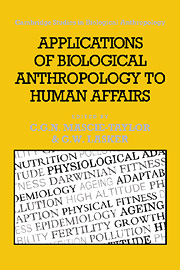Book contents
- Frontmatter
- Contents
- List of contributors
- 1 Introduction
- 2 Reproductive ecology and human fertility
- 3 Nutritional status: its measurement and relation to health
- 4 Pollution and human growth: lead, noise, polychlorobiphenyl compounds and toxic wastes
- 5 Human physiological adaptation to high-altitude environments
- 6 Darwinian fitness, physical fitness and physical activity
- 7 Human evolution and the genetic epidemiology of chronic degenerative diseases
- 8 The biology of human aging
- Index
5 - Human physiological adaptation to high-altitude environments
Published online by Cambridge University Press: 03 May 2010
- Frontmatter
- Contents
- List of contributors
- 1 Introduction
- 2 Reproductive ecology and human fertility
- 3 Nutritional status: its measurement and relation to health
- 4 Pollution and human growth: lead, noise, polychlorobiphenyl compounds and toxic wastes
- 5 Human physiological adaptation to high-altitude environments
- 6 Darwinian fitness, physical fitness and physical activity
- 7 Human evolution and the genetic epidemiology of chronic degenerative diseases
- 8 The biology of human aging
- Index
Summary
The evolutionary adaptation of populations to their environments, each with its unique set of interrelated stresses, has resulted in considerable human biological variation (Baker, 1988). Assessing the magnitude of this variation and determining its causes and functional significance is a central concern for the discipline of human biology. In addition, human biological variation has important practical implications, and ones which are sometimes overlooked, for some aspects of the implementation of public health programmes. As one example, assuming that milk was equally nutritious for all individuals, European nations frequently included dehydrated milk in their food supplementation programmes to African and Asian countries after World War II. However, many Africans and Asians possess significantly lower concentrations than Europeans of the enzyme lactase, which is required for the digestion of the lactose in milk. As a result, the ingestion of milk irritated the intestine and thus frequently resulted in diarrhoea (Baker, 1988). In other words, a lack of knowledge about biological variation led to the development of an inappropriate, and in fact highly maladaptive, programme.
One successful research strategy developed and utilized by human biologists for examining biological variation and for assessing its functional significance involves measuring human biological responses to severe environmental stresses (Baker, 1988). A particularly fruitful area of such research has involved determining the biological consequences of exposure to the decrease in oxygen availability which occurs in high-altitude environments.
- Type
- Chapter
- Information
- Applications of Biological Anthropology to Human Affairs , pp. 117 - 142Publisher: Cambridge University PressPrint publication year: 1991
- 5
- Cited by



